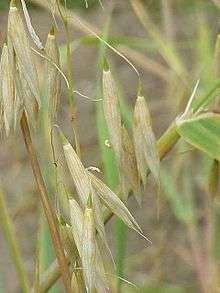Avena nuda
Avena nuda (hulless oat, naked oat[2]) is a species of grass with edible seeds in the oat genus Avena.
| Avena nuda | |
|---|---|
 | |
| Scientific classification | |
| Kingdom: | Plantae |
| Clade: | Tracheophytes |
| Clade: | Angiosperms |
| Clade: | Monocots |
| Clade: | Commelinids |
| Order: | Poales |
| Family: | Poaceae |
| Subfamily: | Pooideae |
| Genus: | Avena |
| Species: | A. nuda |
| Binomial name | |
| Avena nuda | |
| Synonyms[1] | |
| |
| Wikimedia Commons has media related to Avena nuda. |
When threshed, the hull separates quite readily from the grain.[3]
Pillas
A type of naked oat called pillas, pilez, or pil-corn in the Cornish language and dialect of English[4] may have been the same species as Avena nuda. Ray calls it Avena minuta.[5] Well known in the 17th century it was commonly grown in Cornwall as late as the 18th and 19th centuries.[6] The last known crop was harvested at Sancreed in 1867.[7]
In form pillas is described as being similar to rye, but with much finer straw. The straw, being much softer and tougher than wheat straw, was used for plaiting hats.[7]
The small yellow grain was seldom ground into flour but was made into a type of porridge known as gurts. Pillas gurts were prepared by damping the grain and leaving it to stand in a warm place until it started to cheeny (sprout). It was then put in a baker (iron pan) and stirred over a slow fire until completely dry and a little scroached (scorched). The grain was then left to cool spread out on a cloth before being crushed a handful at a time in a small granite trough with a large round bowel (pebble). As well as being made into porridge with milk the gurts were often used in place of flour or rice in puddings. A small amount was also added by the old housewives to the malt when extra strong ale was required. It was for that latter use that old women were threatened with fines by the excisemen if they continued to put their grain to cheeny.[7]
References
- "The Plant List: A Working List of All Plant Species".
- "BSBI List 2007". Botanical Society of Britain and Ireland. Archived from the original (xls) on 2015-01-25. Retrieved 2014-10-17.
- Plants for a Future: Avena nuda
- Lysons, Daniel (1814). Magna Britannia: Cornwall. T. Cadell and W. Davies. p. cciii.
- Miller, Edward; Finberg, H. P. R.; Thirsk, Joan (1991). The Agrarian History of England and Wales: 1348-1500. Cambridge University Press. p. 303.
- Borlase, William (1758) Natural History of Cornwall ... Oxford: printed for the author; by W. Jackson: sold by W. Sandby, at the Ship in Fleet-Street London; and the booksellers of Oxford; reissued by E & W Books, London, 1970; p. 89
- Hamilton Jenkin, A. K. (1946). Cornwall and its People. London: J. M. Dent and Sons. pp. 378, 379.